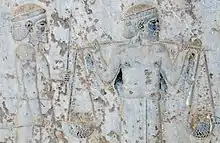𐏃𐎡𐎯𐎢𐎹
Old Persian

An early 5th century BC relief of Indian tribute bearers. This relief is from the eastern stairs leading to the Apadana at Persepolis.
Etymology
Masculine gender adjective formed from 𐏃𐎡𐎯𐎢𐏁 (h-i-du-u-š /Hiⁿduš/, “India”) + -𐎹 (-y /-yaʰ/, adjectival suffix), used as a substantive.
Related terms
- 𐏃𐎡𐎯𐎢𐏁 (h-i-du-u-š) (Hiⁿduš)
Descendants
References
- Text: A.2P, Part No. 130, Old Persian Corpus, TITUS: Thesaurus Indogermanischer Text- und Sprachmaterialien
- MacKenzie, D. N. (1971), “Hindūg”, in A concise Pahlavi dictionary, London, New York, Toronto: Oxford University Press, page 43
- Tavernier, Jan (2007) Iranica in the Achaemenid Period (ca. 550–330 B.C.): Lexicon of Old Iranian Proper Names and Loanwords, Attested in Non-Iranian Texts, Peeters Publishers, →ISBN
- Cuneiform Texts in The Metropolitan Museum of Art Volume IV: The Ebabbar Temple Archive and Other Texts from the Fourth to the First Millennium B.C. Ira Spar, Michael Jursa Metropolitan Museum of Art, 1 août 2014
This article is issued from Wiktionary. The text is licensed under Creative Commons - Attribution - Sharealike. Additional terms may apply for the media files.